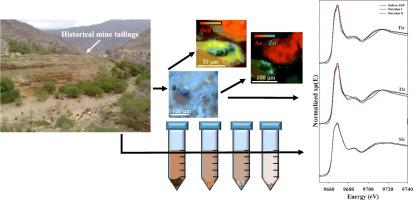当前位置:
X-MOL 学术
›
Chem. Geol.
›
论文详情
Our official English website, www.x-mol.net, welcomes your
feedback! (Note: you will need to create a separate account there.)
Multi-synchrotron techniques to constrain mobility and speciation of Zn associated with historical mine tailings
Chemical Geology ( IF 3.6 ) Pub Date : 2020-12-01 , DOI: 10.1016/j.chemgeo.2020.119866 G. Cruz-Jiménez , R. Loredo-Portales , R. Del Rio-Salas , V. Moreno-Rodríguez , H. Castillo-Michel , L.R. Ramiro-Bautista , G. Aquilanti , Ma.G. De La Rosa-Álvarez , D.O. Rocha-Amador
Chemical Geology ( IF 3.6 ) Pub Date : 2020-12-01 , DOI: 10.1016/j.chemgeo.2020.119866 G. Cruz-Jiménez , R. Loredo-Portales , R. Del Rio-Salas , V. Moreno-Rodríguez , H. Castillo-Michel , L.R. Ramiro-Bautista , G. Aquilanti , Ma.G. De La Rosa-Álvarez , D.O. Rocha-Amador

|
Abstract Zinc speciation, chemical forms, and phytoavailability were determined within mine tailings and soil samples from a historical mining site in the Xichu district, central Mexico. For this purpose, species determination and phase mapping were conducted using XAS, μ-XRF, and μ-XRD, and chemical extraction was performed to assess chemical forms and phytoavailability. High concentrations of Zn were recorded in the mine tailings (4681 mg·kg−1) and relatively high concentrations were observed in the soils (319 mg·kg−1). Soil samples either exceeded the threshold value for exploratory assessment or yielded concentrations that may cause ecological risk. Igeo values indicate that the mine tailings were extremely polluted and soils were unpolluted to moderately polluted. Phytoavailable Zn positively correlated with total Zn content in the mine tailings (34%; 1719 mg·kg−1) and soils (36%; 69.5 mg·kg−1) and exceeded the threshold value for the development of ecotoxicological effects. The average percentages of most mobile fractions (water-soluble, exchangeable, and carbonate-bound) in surficial and composite mine tailings were ~31% and ~34%, respectively, whereas that in the surrounding soils was ~36%. According to XAS and linear combination fitting, the main phases of Zn in mine tailings were residual species, whereas in soils, the main phase was zinc carbonate (hydrozincite). Minor components of Zn were found as sulfate and sorbed onto goethite, which was confirmed by μ-XRD phase mapping. Synchrotron techniques suggest that Zn sulfate and Zn sorbed onto goethite are the main species controlling the mobility and availability of Zn. The potential high mobilization and dispersion of Zn represent potential harm to surrounding ecosystems in the historical mine tailings of central Mexico.
中文翻译:

限制与历史尾矿相关的锌的迁移率和形态的多同步加速器技术
摘要 在墨西哥中部西楚区一个历史矿场的尾矿和土壤样品中测定了锌的形态、化学形式和植物有效性。为此,使用 XAS、μ-XRF 和 μ-XRD 进行物种确定和相映射,并进行化学提取以评估化学形式和植物有效性。在尾矿中记录到高浓度的锌 (4681 mg·kg-1),在土壤中观察到相对高的浓度 (319 mg·kg-1)。土壤样本要么超过了探索性评估的阈值,要么产生了可能导致生态风险的浓度。Igeo 值表明尾矿污染严重,土壤未受污染至中度污染。植物可利用锌与尾矿(34%;1719 mg·kg-1)和土壤(36%;69.5 mg·kg-1)中的总锌含量呈正相关,并且超过了生态毒理学效应发展的阈值。表层尾矿和复合尾矿中大多数流动组分(水溶性、可交换和碳酸盐结合)的平均百分比分别为~31% 和~34%,而在周围土壤中为~36%。根据 XAS 和线性组合拟合,尾矿中 Zn 的主要相为残留物种,而在土壤中,主要相为碳酸锌(水锌矿)。Zn 的微量成分以硫酸盐的形式被发现并吸附在针铁矿上,这通过 μ-XRD 相图得到证实。同步加速器技术表明硫酸锌和吸附在针铁矿上的锌是控制锌迁移率和可用性的主要物质。锌的潜在高流动性和分散性代表了墨西哥中部历史尾矿中对周围生态系统的潜在危害。
更新日期:2020-12-01
中文翻译:

限制与历史尾矿相关的锌的迁移率和形态的多同步加速器技术
摘要 在墨西哥中部西楚区一个历史矿场的尾矿和土壤样品中测定了锌的形态、化学形式和植物有效性。为此,使用 XAS、μ-XRF 和 μ-XRD 进行物种确定和相映射,并进行化学提取以评估化学形式和植物有效性。在尾矿中记录到高浓度的锌 (4681 mg·kg-1),在土壤中观察到相对高的浓度 (319 mg·kg-1)。土壤样本要么超过了探索性评估的阈值,要么产生了可能导致生态风险的浓度。Igeo 值表明尾矿污染严重,土壤未受污染至中度污染。植物可利用锌与尾矿(34%;1719 mg·kg-1)和土壤(36%;69.5 mg·kg-1)中的总锌含量呈正相关,并且超过了生态毒理学效应发展的阈值。表层尾矿和复合尾矿中大多数流动组分(水溶性、可交换和碳酸盐结合)的平均百分比分别为~31% 和~34%,而在周围土壤中为~36%。根据 XAS 和线性组合拟合,尾矿中 Zn 的主要相为残留物种,而在土壤中,主要相为碳酸锌(水锌矿)。Zn 的微量成分以硫酸盐的形式被发现并吸附在针铁矿上,这通过 μ-XRD 相图得到证实。同步加速器技术表明硫酸锌和吸附在针铁矿上的锌是控制锌迁移率和可用性的主要物质。锌的潜在高流动性和分散性代表了墨西哥中部历史尾矿中对周围生态系统的潜在危害。









































 京公网安备 11010802027423号
京公网安备 11010802027423号